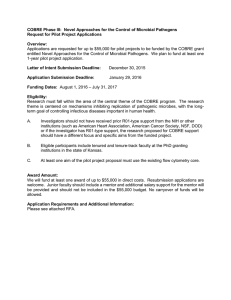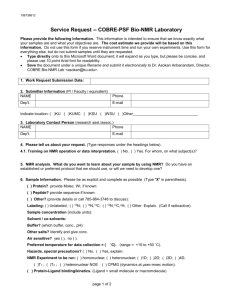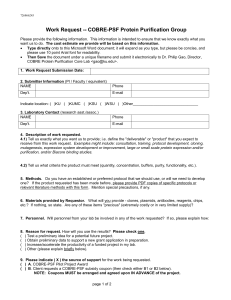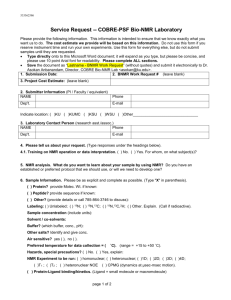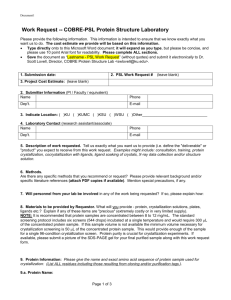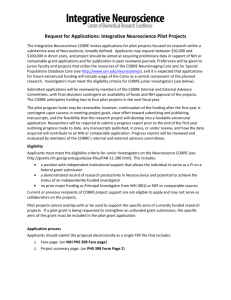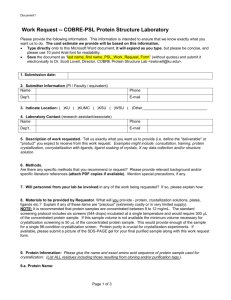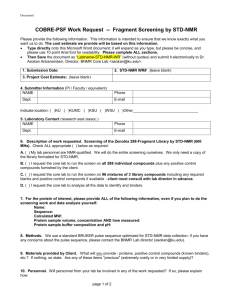University of Kansas NIH COBRE Center for Molecular Analysis of... Pilot Project Competition
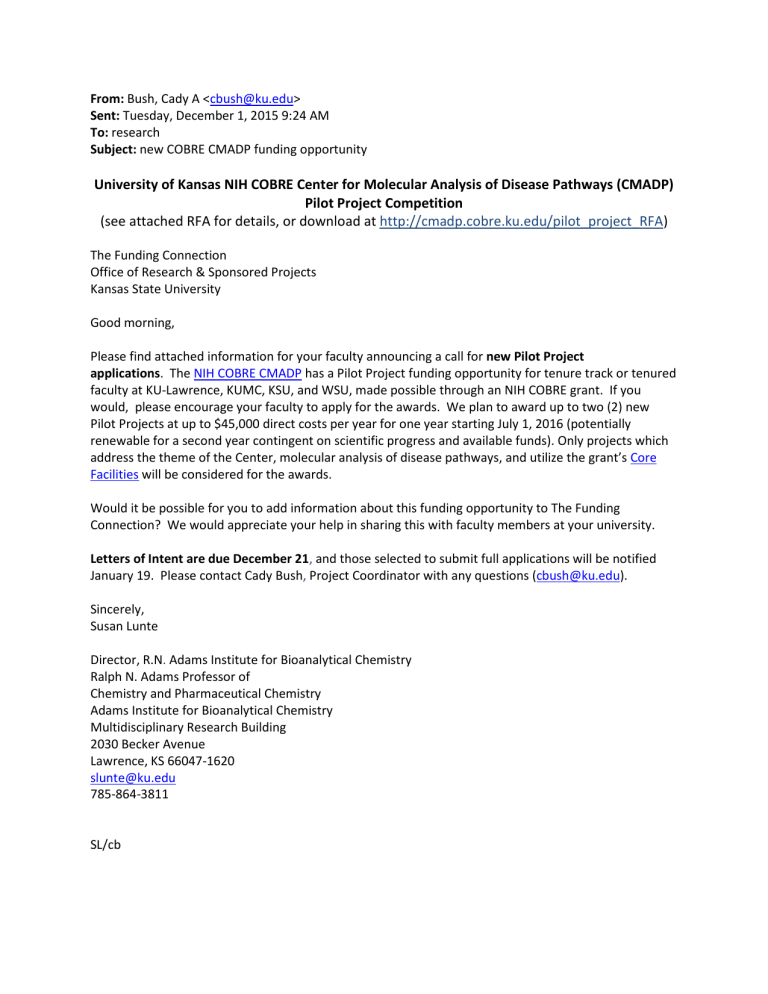
From: Bush, Cady A < cbush@ku.edu
>
Sent: Tuesday, December 1, 2015 9:24 AM
To: research
Subject: new COBRE CMADP funding opportunity
University of Kansas NIH COBRE Center for Molecular Analysis of Disease Pathways (CMADP)
Pilot Project Competition
(see attached RFA for details, or download at http://cmadp.cobre.ku.edu/pilot_project_RFA )
The Funding Connection
Office of Research & Sponsored Projects
Kansas State University
Good morning,
Please find attached information for your faculty announcing a call for new Pilot Project applications . The NIH COBRE CMADP has a Pilot Project funding opportunity for tenure track or tenured faculty at KU-Lawrence, KUMC, KSU, and WSU, made possible through an NIH COBRE grant. If you would, please encourage your faculty to apply for the awards. We plan to award up to two (2) new
Pilot Projects at up to $45,000 direct costs per year for one year starting July 1, 2016 (potentially renewable for a second year contingent on scientific progress and available funds). Only projects which address the theme of the Center, molecular analysis of disease pathways, and utilize the grant’s Core
Facilities will be considered for the awards.
Would it be possible for you to add information about this funding opportunity to The Funding
Connection? We would appreciate your help in sharing this with faculty members at your university.
Letters of Intent are due December 21 , and those selected to submit full applications will be notified
January 19. Please contact Cady Bush , Project Coordinator with any questions ( cbush@ku.edu
).
Sincerely,
Susan Lunte
Director, R.N
.
Adams Institute for Bioanalytical Chemistry
Ralph N. Adams Professor of
Chemistry and Pharmaceutical Chemistry
Adams Institute for Bioanalytical Chemistry
Multidisciplinary Research Building
2030 Becker Avenue
Lawrence, KS 66047-1620 slunte@ku.edu
785-864-3811
SL/cb
Pilot Project
Call for Applications
Letter of Intent due December 21, 2015
Those selected to submit full applications will be notified January 19, 2016.
Selected full applications due February 22, 2016
Anticipated start date: July 1, 2016
The NIH COBRE Center for Molecular Analysis of Disease Pathways (CMADP) at the University of Kansas provides participating investigators with research support, mentoring and access to Core Lab Services in a collegial, collaborative atmosphere.
We anticipate being able to support up to two (2) new Pilot Projects at up to $45,000 direct costs per year for one year starting July 1, 2016.
These projects will potentially be renewable for a second year contingent on scientific progress and available funds.
Applications must describe a research project that fits well with the scientific theme of our Center and that will make good use of one or more of the
CMADP Core Labs .
This competition is open to all full time, tenure-track, or tenured faculty at
KU-L, KSU, WSU or KUMC whose research embraces the molecular analysis of disease pathways in the broadest sense.
CMADP Web Site: http://cmadp.cobre.ku.edu
Download RFA: http://cmadp.cobre.ku.edu/pilot_project_RFA
For additional information, contact:
Cady Bush, COBRE CMADP Program Coordinator cbush@ku.edu
Pilot Project Call for Applications
_________________________________
Letter of Intent due December 21, 2015
Those selected to submit full applications will be notified on January 19, 2016.
Selected full applications due February 22, 2016
Anticipated start date: July 1, 2016
NIH Center of Biomedical Research Excellence
Center for Molecular Analysis of Disease Pathways
( http://cmadp.cobre.ku.edu
)
Summary:
The Center for Molecular Analysis of Disease Pathways (CMADP) at the University of Kansas provides participating investigators with research support, mentoring and access to Core Lab Services in a collegial, collaborative atmosphere. We anticipate being able to support up to two (2) new Pilot Projects at up to $45,000 direct costs per year for one year, starting July 1, 2016.
(These projects will potentially be renewable for a second year contingent on scientific progress and available funds.) Applications must describe a research project that fits well with the scientific theme of our Center and that will make good use of one or more of the CMADP Core Labs ( http://cmadp.cobre.ku.edu/cores ). This competition is open to all full time, tenure-track, or tenured faculty at KU-L, KSU, WSU or KUMC whose research embraces the molecular analysis of disease pathways in the broadest sense.
1.
Introduction
1.1.
The COBRE program is an initiative of the NIH-NIGMS. COBRE Centers are intended to:
• Focus on a single research area (e.g., molecular analysis of disease pathways);
• Augment and strengthen biomedical faculty research capability;
• Provide flexible support to build research capacity;
• Enhance research infrastructure;
• Encourage collaborative research and research grant applications ;
• Foster health-related research.
The official RFA under which our COBRE Center is funded may be found at this URL: http://grants.nih.gov/grants/guide/pa-files/PAR-09-079.html
The COBRE RFA states: “For the purpose of eligibility, a junior investigator is defined either as (1) an individual who does not have or has not previously had an external, peer-reviewed Research Project Grant
(RPG) or Program Project Grant (PPG) from either a Federal or non-Federal source that names that investigator as the PI or (2) an established investigator who is making a significant change to his/her career.
The intent of this FOA is to allow promising investigators whose early career support consists of awards geared
NIH COBRE CMADP Call for Applications Page 1 of 5 Issue Date: 11/30/2015
toward initiating their intended area of research.
Support may be provided to an established investigator who is making a significant change to his/her career goals by initiating a new line of research that is distinctly and significantly different from his/her current investigative program. The current or previous history of independent peer-reviewed research support, which should be indicated in the Biographical Sketch, in a different investigative area than that proposed in this application does not disqualify the investigator.
Furthermore, this individual can be of any faculty rank. Note that the intent of this initiative is to allow established investigators the opportunity to initiate and develop a new line of research. However, investigators whose current research is already supported by a RPG or PPG and who are not changing their current research program are not eligible.”
1.2.
COBRE Pilot Project Leaders are full time, tenure-track, or tenured faculty who are developing a promising new line of research that incorporates a significant emphasis on molecular analysis of disease pathways, and that will take advantage of both the Center’s Core Labs and the interactivity among Center participants. Pilot
Project Leaders may be junior faculty, former COBRE awardees, or more established faculty researchers whose active participation will strengthen the Center overall. Pilot Project Leaders will receive project support of up to
$45,000 per year (direct costs) for one year, potentially renewable for a second year contingent on scientific progress and available funds.
Research areas eligible for funding . Because COBRE Centers are expected to have a thematic scientific focus, research projects must fit the COBRE theme of molecular analysis of disease pathways. Successful applications may incorporate one or more of the following topics in significant depth:
• the development of new probes that can be used to study cellular and molecular functions in living model organisms or cells
• new imaging approaches for studying disease pathways
• micro- or nanotechnology-based methods for studying disease pathways
• new sensing technologies
• development of innovative platforms and devices on which to analyze biological specimens for such things as microscopy and chemical analytics
• the use of next-generation sequencing (e.g. genome sequencing, RNA seq, ChIP seq) to analyze biological pathways relevant to disease in the broadest sense
• investigations involving model organisms for studying disease
More information on the overall goals of the Center are provided on the COBRE website ( http://cmadp.cobre.ku.edu
) .
1.3.
Criteria for evaluation of COBRE applications. The basic criteria for NIH grant review may be found at http://grants.nih.gov/grants/peer/peer.htm
.
Strength of the science and the quality and clarity of its presentation;
Likelihood of the project becoming competitive for independent R01 funding;
Likelihood of getting a publishable result within the one-year time frame;
Relevance to the COBRE theme of molecular analysis of disease pathways (see above and CMADP website);
A clear, detailed plan for utilization of one or more COBRE Core Laboratories;
Background, experience and career status of the applicant;
A track record of past research, research grant applications and research funding.
COBRE Projects must have a single Principal Investigator who will be responsible for the scientific direction and management of the project. Applications may involve collaborators, but only when they bring complementary investigator strengths and approaches to the project. All collaborators receiving COBRE funds must be from
Kansas institutions. A possible exception is a collaborator who provides specialized research services to
PIs/clients on an established fee-for-service basis.
NIH COBRE CMADP Call for Applications Page 2 of 5 Issue Date: 11/30/2015
1.4.
General Terms and Conditions of COBRE CMADP Pilot Project Awards:
1.
New PIs not previously funded by COBRE are encouraged to apply.
2.
In general, priority will be given to projects that make significant use of COBRE Core Labs.
3.
For Pilot Projects, PI summer salary is limited to a maximum of one month.
4.
Funds may be used for consumable supplies, services or small laboratory hardware but not for equipment
(i.e. items costing > $5000). Personnel costs are allowable but preference will be given to applications that name specific individuals who are assured to be present on-site, eligible to work and ready to begin no later than July 1, 2016. Travel costs may include essential research-related travel and participation in national/regional scientific meetings. Tuition costs are allowable as per standard NIH/institution policies.
5.
Investigators who receive COBRE support are required to participate as fully as possible in the regular research meetings of the Center, as well as seminars, workshops and other special activities organized or sponsored by the Center.
6.
A standard NIH-type progress report (ca. 2 pages in length) is required from each COBRE project investigator by January 1st of each year.
7.
Term and budget adjustments: The COBRE Director reserves the right to make term and budget adjustments in accordance with the intent of the COBRE CMADP program and NIH policies concerning scientific overlap of projects. For example, if a COBRE Investigator receives his/her own NIH R01 grant, the
COBRE grant may be reduced to adjust for overlap, up to and including 100% reduction if the scientific overlap is extensive.
8.
Unanticipated new requirements: By accepting COBRE funds, awardees agree to comply with any and all requirements not already mentioned that may be imposed on COBRE CMADP by NIH or other institutional authorities.
Prospective applicants with questions about eligibility, program details, or the “fit” of their project to the
COBRE theme are encouraged to contact Dr. Susan Lunte (785-864-3811; slunte@ku.edu
).
2.
The Application Process
Step 1 - Send Email Letter of Intent (These required letters help us in planning.)
Letters of intent should be sent as a PDF via email to Cady Bush, COBRE CMADP Program Coordinator
( cbush@ku.edu
). Your letter of intent must:
• Be received by Monday, December 21, 2015;
• Be no longer than one page, sent by email as a PDF attachment along with the applicant’s NIH biosketch;
• Explain briefly how the applicant meets the eligibility criteria set forth in Section 1 above;
• Explain briefly the nature or focus of the research that will be proposed and, if not obvious, how it fits the scientific theme of COBRE CMADP, and
• Explain briefly how the project will utilize one or more of the COBRE CMADP Core Labs.
• Along with your letter, please also include a separate listing of complete contact information (including website URL if possible) for five (5) potential reviewers for your application. For convenience and familiarity with NIH grant systems, these individuals must be located in the U.S., and must NOT currently be serving on an NIH study section.
Based on your letter, you will be notified on Tuesday, January 19, 2016 if you should prepare and submit a full application.
NIH COBRE CMADP Call for Applications Page 3 of 5 Issue Date: 11/30/2015
Step 2 - Prepare and Submit a Complete Application.
Applications should be prepared in general accord with the NIH PHS 398 application guidelines, (8/2012 revision, available from http://grants.nih.gov/grants/funding/phs398/phs398.html
). In the Instructions, note particularly
Part I, Sections 2.6, 5.5.2, 5.5.3 and 5.5.5. Include:
Form Page 1: Face Page,
Form Page 2: Project Summary, Relevance, Project/Performance Site(s), Senior/Key Personnel, Other
Significant Contributors, and Human Embryonic Stem Cells (include Senior Key Personnel information),
Form Page 4: Detailed Budget for Initial Budget Period (and a budget explanation/justification),
Biographical Sketch Format Page. Omit the Table of Contents page and the Resources page (unless you have something unique to mention),
Research Plan,
References,
Instead of using PHS Other Support pages, use the alternate instructions “D” and “E” below. Appendices are not allowed.
Checklist Form Page.
In addition, please observe the following COBRE-specific requirements:
A.
The research plan may not exceed five (5) pages in length including figures and tables but excluding references (which must be complete citations in the NIH style). The Specific Aims section must fit entirely on one page ( maximum of two specific aims for a Pilot Project), and is not included in the 5-page limit for the research plan. Include sections 5.5.6 through 5.5.15 only if applicable to your application.
B.
Please use 11-point Arial font with one (1)-inch margins on all four sides. (Write concisely and limit the amount of general background to the essentials that reviewers will need to be aware of to appreciate the proposed research.)
C.
All figures and their lettering must be large enough to be clearly legible.
D.
Other Support. Provide a listing of all current research support from all sources. For each source listed, please provide the following information: Name of funding source, title of project, project start/end dates, and amount of direct costs available (or available to you if a multi-PI grant), and percent effort. If you are a junior faculty member, please include the following details of your startup package in this list: amount initially provided, current unspent balance, and expiration date or other restrictions if any.
E.
Provide a listing of all grant applications submitted during the past two calendar years (i.e. 2014 and 2015).
For each application submitted, please provide the following information: Date of submission, name of granting agency, title of project, project start/end dates requested, and amount of direct costs requested.
You are encouraged to obtain assistance from the appropriate Grant Services agency at your university.
Suggested contacts are listed below:
KSU Office of Research and Sponsored Projects
785-532-6195 research@k-state.edu
KU Higuchi Biosciences Center Proposal Preparation Office
785-864-4244 or 785-864-8015 hbcgrant@ku.edu
KUMC Sponsored Programs Administration
913-588-1251 spa@kumc.edu
WSU Office of Research and Technology Transfer
316-978-3285 proposals@wichita.edu
NIH COBRE CMADP Call for Applications Page 4 of 5 Issue Date: 11/30/2015
3.
COBRE Application Package and Checklist
Please type the applicant's name in the upper right hand corner of every page. Number pages consecutively starting with the face page of the NIH PHS 398 form as page 1.
Please use 11 point Arial font and one (1)-inch margins on all four sides.
Observe the strict five (5)-page limit on the research plan (including figures and tables but excluding references and the one-page Specific Aims section).
No appendices or additional email attachments should be submitted with the application.
The last page of the application should be the NIH Checklist page.
If selected for funding , applicants will be required to furnish copies of all relevant compliance approvals
(radioisotopes, recombinant DNA, vertebrate animals, etc.) to the COBRE CMADP office prior to release of award funds, but do not submit these items at this time.
4.
Submission of Application Package
Please submit applications via email on NIH PHS 398 forms (as a single PDF document) to cbush@ku.edu
.
Applications must be received no later than 5:00 PM CST, Monday, February 22, 2016.
5.
Review of Applications
COBRE Pilot Project applications will be reviewed administratively according to the NIH criteria and the COBREspecific criteria mentioned above. We anticipate that applicants will be notified of funding decisions in early April
2016.
NIH COBRE CMADP Call for Applications Page 5 of 5 Issue Date: 11/30/2015
157 Multidisciplinary Research Building (MRB)
2030 Becker Drive, Lawrence, KS 66047
Susan Lunte, Ph.D., Core Leader, slunte@ku.edu, (785) 864-3811
Ryan Grigsby, Core Director, ryan.grigsby@ku.edu, (785) 864-1918 http://microfab.ku.edu
The Ralph N. Adams Institute Microfabrication Facility is a 2400 ft 2 ISO Class
5 and 6 facility that specializes in the manufacture of microfluidic devices. Our equipment versatility can also be utilized for the manufacture and evaluation of a variety of micro-scale devices and materials. We offer our services to KU research groups, as well as research groups from other universities and private institutions.
Services Offered
Microfluidic Device Fabrication
Material availability: soda-lime and borosilicate glass, PMMA, and PDMS
Embedded electrodes: carbon, platinum, nickel, copper, chromium
Device and material evaluation: step profiling, ellipsometry, image capture
Consultation
Photomask design
Limited open access
Includes training and support
Multiple rates available to suit users’ needs
Core Equipment
Amray 1810 Tungsten Filament
Scanning Electron Microscope
Thermionics VE-100 E-beam evaporator
Lesker DC magnetron sputterer with three Torus guns
Oxford Plasmalab 80 Plus Plasma-
Enhanced Chemical Vapor Deposition
System: Silicon Dioxide and Silicon
Nitride deposition currently available
Oxford Plasma Plasmalab System 100 Inductively-Coupled Plasma Reactive Ion
Etch System
HORIBA Jobin Yvon UVISEL Spectroscopic Elipsometer
ABM, Inc. i-line UV flood source and mask aligner
WABECO 3-Axis CNC Mill
Genome Sequencing Core
for next generation DNA sequencing services
Molecular Probes Core
for design, synthesis and evaluation of novel fluorescent probes of biochemical pathways in model organisms
Microfabrication and Microfluidics Core
for production of unique microfabricated devices for studying genetically modified organisms and biological pathways supported by the National Institute Of General Medical Sciences of the National Institutes of Health under Award Number P20GM103638 http://cmadp.cobre.ku.edu
1030 Haworth Hall
1200 Sunnyside Avenue, Lawrence, KS 66045
Erik A. Lundquist, Ph.D., Core Leader, erikl@ku.edu (785) 864-5853
Jennifer Hackett, M.S., Core Director, jhackett@ku.edu, (785) 864-7023 http://gsc.ku.edu
The GSC offers next generation DNA sequencing services for researchers at
KU and other institutions. As opposed to “standard” Sanger sequencing, next generation sequencing has astronomically higher throughput (billions of reads and hundreds of Gbs of data), allowing whole genome sequencing in a single run and allowing deep, quantitative analysis of genome-wide gene expression
(transcriptomics), among others.
Services Offered
Genome re-sequencing:
Mutant identification (model organisms, human syndromes)
Evolutionary comparisons
Disease tissue sequencing (e.g. cancer)
Genotyping: single nucleotide polymorphisms (SNPs), copy number variations
(CNVs), genome-wide association studies (GWAS), & linkage analysis
De novo genome assembly: new un-sequenced species
Expression analysis (transcriptomics): cDNA sequencing (RNA-Seq) for deep and quantitative analysis of genome-wide gene expression
Epigenomic & gene regulation analyses
Chromatin immunoprecipitation sequencing (ChIP-Seq) to find binding sites of transcription factors or other DNA-interacting proteins
Methylated DNA sequencing (Methyl-Seq) to identify methylated regions of the genome
Small RNA discovery and analysis
Core Equipment
Illumina Hiseq 2500
Next Generation Sequencer
Normal mode (more data, more time)
3-6 billion reads of 100 bp per run of two eight-lane flow cells (600Gb data)
Single reads or paired end reads (both ends of the DNA fragment)
~5-11 day run time
Rapid Mode (less data, less time)
1.2 billion reads of 150 bp per run on two two-lane flow cells (120 Gb data)
~27 hour run time
1053 Structural Biology Center (SBC)
2034 Becker Drive, Lawrence, KS 66047
Blake Peterson, Ph.D., Core Leader, brpeters@ku.edu, (785) 864-8156
Chamani Perera, Ph.D., Core Director, chamani@ku.edu, (785) 864-6193 http://mpc.ku.edu
The MPC provides researchers with access to a wide variety of commerciallyavailable and custom-synthesized fluorescent probes as well as microscopybased analysis of fluorescent small molecules and proteins in the model organisms Caenorhabditis elegans (nematode worm) and Danio rerio (zebrafish).
Services Offered
Design, synthesis, and evaluation of novel fluorescent probes
Fluorescent probes for studies of biology and models of disease
Housing, care, and cryopreservation of C. elegans and D. rerio animals
Access to models of human disease in C. elegans and D. rerio
High-resolution video microscopy imaging of fluorescent probes in vivo
Qualitative and quantitative image and video data analysis
Structure-activity studies and genotype vs. distribution relationships in vivo
Microinjection for probe administration and generation of transgenic organisms
Digital archiving of images and video microscopy data
Core Equipment
Zeiss AxioZoom V16 stereoscope fitted with a Hamamatsu ORCA-Flash4.0 sCMOS camera and Sutter DG5 fast filter switching excitation source
Pentair Aquatic Habitats ZF0601 zebrafish habitat system
